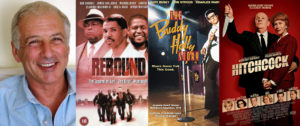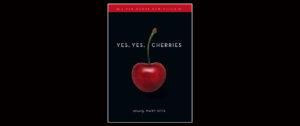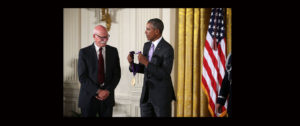Reviewed by James Victor Jordan:
This is a review of the audio recording of T.C. Boyle’s story collection, A Death in Kitchawank. The narrator is the author, T.C. Boyle. I award the collection and the narration each a well-deserved five stars.
Had it been separately published in print, A Death in Kitchawank and Other Stories would have been T.C. Boyle’s ninth story collection in print form, excluding the two compendiums of his stories T.C. Boyle Stories I and II and a special collection of previously published stories selected as being suitable for the young-adult market: The Human Fly. Instead A Death in Kitchawank and Other Stories is available as a collection in print only as a bonus collection of fourteen stories in T.C. Boyle Stories II (2013), together with three other previously published T.C. Boyle story collections—After the Plague (2001), Tooth and Claw (2005), and Wild Child (2010).
Each of the stories in the A Death in Kitchawank and Other Stories collection is as good as literary fiction gets. As a collection, it’s a tour de force of short fiction. In this review I support these superlatives in my discussion of three stories in the collection: “In the Zone” first published by The Kenyon Review in 2011, “Slate Mountain” first published by The Kenyon Review in 2013, and “A Death in Kitchawank” first published in The New Yorker in 2010.
Are these the best stories in the collection? They are three stories among the fourteen that I find especially compelling, a fair representation, a flavor if you will, of the collection. Each is thought provoking and palpably poignant.
In this review, the spoiler-alert factor descends with the most said about “In the Zone” in terms of the plot and ending and with just enough said about “A Death in Kitchawank” to support my evaluation of that story and to whet the appetite.
A recurring topic found in T.C. Boyle stories is the toll on the environment by monumental natural and human-caused disasters and the translation of those catastrophes into personal terms: their effects on individuals. E.g. “Chicxulub” published in The New Yorker in 2004 and A Friend of the Earth, Dr. Boyle’s novel published in 2000. At times this theme warns, at times it’s metaphorical, and at times it’s simply a sad recognition of our hapless march to extinction. The first two stories I discuss are emblematic of this theme: the examination of an environmental disaster in “In the Zone” and reflection on a disaster wrought by the environment in personal, i.e. human, terms.
“In the Zone.”
In 2019, the HBO miniseries Chernobyl aired to critical and popular acclaim. I was astounded by its brilliance, its historical and human revelations—the horror of the disaster as well as the not-surprising coverup by the (evil) Soviet Empire. I was not far into viewing the first episode of Chernobyl when I remembered a similar feeling of astonishment, of revelation when I first read “In the Zone.” The nuclear disaster at Chernobyl occurred in 1986. When “In the Zone” was published in 2011, the accident was not widely understood in the west and had long since been breaking news. This story shined a well and long overdue spotlight on that tragedy through the medium of literary fiction.
Topics explored in T.C. Boyle’s fiction are often the subject of subsequent books, stories, or movies, so often in fact that I experience an impression that Dr. Boyle is prescient. For example, the September 2004 publication of his novel, The Inner Circle—historical fiction centered on the life and work of Alfred Kinsey—was followed in November 2004 with the release of the biopic Kinsey, starring Liam Neeson. It is rewarding to read the book and then see the movie, or vice versa. The same can be said of Chernobyl and “In the Zone.” After seeing Chernobyl, I eagerly reread the story. And subsequently it was a treat to hear T.C. Boyle read the story. Each time I read “In the Zone,” and after I listened to it, I had a deeper appreciation of the consequences of the event and of the story as well.
Chernobyl, the miniseries, presents a macro view of what occurred, how it occurred, and the suffering of the workers at the plant, the first responders, and the investigators. But Chernobyl only marginally touches the surface of the experiences of the local villagers displaced by the disaster—the viewer sees the forced evacuation of villagers, the subsequent execution of their pets they were forced to leave behind. But nothing is shown of their lives before, during, or after the forced evacuation.
“In the Zone,” a microcosm of the Chernobyl nuclear conflagration, tells the story three years after the meltdown of a reactor at the Chernobyl facility of two characters who had been villagers. The reader shares the intimate experiences of this couple in a close third-person narration. The reader is told, in fictive form of course, of consequences to the rural villagers displaced from their bucolic environs and moved into cramped ghetto-like dilapidated soviet style apartments in Kiev; from self-sufficiency via hunting and farming to enforced urban poverty, the largess of their government.
Now, scant months after the inaugural broadcast of Chernobyl, we have learned of the August 2019 Russian nuclear missile accident off the Pacific coast of northern Russia. We know that an untold amount of lethal radiation was released into the atmosphere. But we don’t yet know a whole lot more as we’re witnessing a Russian coverup modeled on the 1986-Soviet-Chernobyl coverup. It’s as if the story and the docudrama are saying, “We must never forget.” Unfortunately, it’s another example of T.C. Boyle’s prescience.
“In the Zone” is a “return to The Garden of Eden” story. When it begins, the story is set in Kiev, where three years after the Chernobyl disaster the widow Maryska Shyshylayeva is living “in an inhuman space in a crumbling apartment block for evacuees.” She is 62-years old and has been warned that if she were to return to her village in the uninhabitable zone, the poison in the air and in the ground, in the food and in the water, will cause cancer in her bones, an excruciating death of near unimaginable suffering.
Conditions in Kiev become unendurable for Maryska. When she learns from Leonid Kovolenko, 67, a friend of her departed husband, that in return for a bribe, to be offered by Leonid, a guard will allow her to return to her village, she and Leonid embark upon a return journey, making their way back to the wasteland of her village. Maryska and Leonid find that their respective homes are intact. They set about restoring their properties after three years of abandonment as best they can. They live off canned goods recovered from the abandoned homes, the land, eating rabbits trapped or shot by Leonid, fruit they harvast and eventually crops they cultivate. Animals—roe deer, wolves, moose, boar, squirrels—have returned. Or maybe they never left.
Maryska and Leonid are Adam and Eve until they discover a young couple with two children, a milk cow, and a dog, who have returned to live nearby in the evacuated village. Maryska and Leonid must know that it is likely that any day one or the other or both will fall ill from radiation poisoning. They live happily one day at a time in classic Freudian denial. But the narrator never says this. Instead the reader learns “That first day was the happiest of her life. She felt like a songbird caged all these years and suddenly set free, felt giddy, a girl all over again.” Maryska and Leonid shortly move in together, become lovers, live as husband and wife.
“And then one morning as they were lingering over breakfast . . . a strange terrible mechanical sound erupted out of nowhere and drove down the chatter of the birds and the symphony of the bees.” The sound came from an auto driven by Nikolai, Maryska’s thirty-six-year-old, fat to the point of obesity, chain smoking son, a professor in Moscow, come to rescue her by persuasion or force from the poison zone. “And in all those days, weeks and months of the three years she was entombed in those apartments [in Kiev] he had visited her exactly once.”
“At first, they talked of little things . . .” and then without self-awareness of the irony given his obese smoke-shrouded unhealthy lifestyle, Nikolai “started in on the subject he’d come expressly to address, or not simply to address but to harangue her with: the poison.” But Maryska won’t go and Nikolai is persuaded to accede to her wishes at the end of the barrel of Leonid’s rifle.
Maryska and Leonid have been told of their likely fate: death by radiation poisoning. But the story continues through another round of the seasons, of renewal and hope all a gift, though it will likely be a short-lived one, of their escape from the squalor imposed upon them in Kiev.
Chernobyl unmasks the coverup, telling, in effect, what happened. “In the Zone” reveals something quite different by comparing an impoverished life of squalor and dependency on the state to the freedom of living on one’s own terms, healthy for a time, in a land of beauty where the stuff of subsistence is plentiful. And what does this have to say about what was taken from these villagers? This is a critical issue beyond the scope of Chernobyl.
“Slate Mountain”
“Slate Mountain” is a story about a very different type of loss. As with “In the Zone,” it is as personal as loss can be, the possible loss of a spouse while hiking on potentially perilous mountain trails. It is a story of confronting loss in the face of hope. I use the word “potentially” because in “Slate Mountain” the outcome is unknown despite the narrator’s hope for a happy ending, a hope that must sustain him through a lonely, cold, wet uncertain night.
The story opens on “a Saturday at the end of October, the leaves bronzing on the lower slopes, deer season safely in the can and the mosquitos gone to mosquito hell till spring at least . . .” Seventeen people have signed up for a hike to be led by the narrator, Brice, and his wife Syl. As with Maryska, in the face of warnings about outdoor dangers, Brice takes his chances on an away-from-home excursion, though on first take, comparing the dangers of the aftereffects of a nuclear disaster to a hiking accident appears to be superficial. Yet the commonality is that in each of these stories, the protagonists choose to ignore warnings about environmental dangers. Though the danger of radiation poisoning in Maryska’s case is an eventual certainty, danger of a mishap while hiking the trails on Slate Mountain are statistically remote. Still the chances taken by the protagonists in each story are rational.
“A Death in Kitchawank”
“A Death in Kitchawank” is a very different kind of story, though the writing, as one would expect of a T.C. Boyle story, is gorgeous. “Saturday, just after two,” the story informs at the outset, “the sun a hot compress on her shoulders and scalp, the shrieks and catcalls of the children as they splash in the shallows a kind of symphony of the usual.”
This is a story of danger where danger should not lurk. It is realistic fiction at its finest. Why? Because the writing is so up close—as great first-person narration should be—that if the reader didn’t know it was fiction, she would likely conclude that it was superb memoir.
The Narration
In conclusion, just a brief word about the narration, the performance of the stories by the author. I’ve listened to many T.C. Boyle books read by him and to others read by professional narrators. As good as the professional narrators have been, not one of their recordings compares to the narrations by T.C. Boyle, including his narration of the stories in A Death in Kitchawank. After wondering why, I think I’ve put my finger on an essential reason. In virtually all, if not all, T.C. Boyle’s fiction there is irony—think of Maryska’s son urging her to leave her village when during the three years she lived in poverty in Kiev, he visited her just once—and satire, humor which offers hope flickering against the onset of the coming void. No narrator of T.C. Boyle’s fiction conveys these nuances as well as T.C. Boyle does. Without question, listening to this collection of stories performed by T.C. Boyle will be a delight.









































